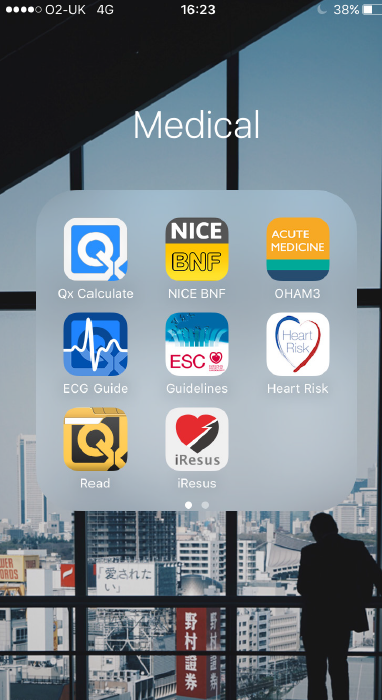Junior doctor Jonathan Bennett reviews cardiovascular apps and makes recommendations to fellow juniors of those he found most useful.
Introduction

In less than a decade since the first iPhone, smartphone technology has become more powerful and portable. The opportunity to become more connected to friends, family and information has been nearly universally embraced.
The ability of the smartphone has not been underestimated, and the development of the mobile health (mHealth) industry has been rapid.1 The approval of iECG2 for mobile patient-lead telemetry, the Dexcom cutaneous blood glucose monitoring3 and most recently the Proteus Digital ingestible sensor to promote medication adherence4 prove, not only how powerful the technology is, but also that people are willing to incorporate it into their lifestyles.
Having signed the contract for my first iPhone in 2013, it has been incorporated into the final years of medical education and been in my pocket for my foundation year training. The app store has on offer >160,000 medical apps,1 which is over 50 being released every day since its inception. A quick glance at this section and you’ll notice that most of these are aimed at the public with the top paid app being one to listen to your baby’s heartbeat.
While I doubt the validity of this claim (and haven’t had the chance to try the app on any pregnant women) there have also been concerns raised of other apps available. Multiple apps promise to measure your blood pressure,5 but in the fine print assert that they are just for fun. This has led to discussions on whether apps promote health or harm,6 and the Royal College of Physicians have advised that if it doesn’t have a CE stamp, health professionals shouldn’t be using apps.7
However, over the years I have built up a small collection of apps that I find myself using at least a few times a week, I’m not alone in this with over 50% of clinicians having apps on their smartphone.8 There have also been many more that have fallen by the wayside for numerous reasons. I’ve found that radiology apps don’t translate well to the small screen of my smartphone and use up far too much storage space. However, the ability (for ~£140 per month) to attach a portable ultrasound probe to your phone and ditch the stethoscope, in possibly the not too distant future, is an exciting prospect (unless you run out of battery).9
But as we aren’t quite there yet, I’d like to share with you the apps that have seen me through medical school and the foundation year programme. Endeavouring to pursue a cardiovascular career they tend to lean towards that field, however, they cover many other bases as well. The perceived efficacy of apps is highly variable,10 therefore, what works for me may not for you. However, if you are coming up to starting foundation year 1 and are mildly apprehensive about your first on-call shift, these apps really did help me through.
ECG Guide by QxMD
Available: iOS, Android
Price: £0.79 (iOS), £3.01 (Android)
QxMD are consistently creating excellent apps aimed squarely at the health professional and have made a few apps that appear in this article. The ECG Guide describes itself as a “critical companion,” and is listed as a core medical app by Georgetown Medical School.
There are over 200 high-quality examples of most conceivable electrocardiograms (ECGs) that fulfil the 2009 American Heart Association (AHA)/American College of Cardiology Foundation (ACCF)/Heart Rhythm Society (HRS) recommendations for the standardisation and interpretation of the ECG. The bulk of the content is focused bullet-pointed lists with a zoomable accompanying ECG. There is usually a brief description and differential attached, however, in-depth explanations will need to be found elsewhere.
ECG Source is another good app covering the same content, however, ECG Guide has very slick formatting that is easy to navigate. This is probably my most used app, I consistently use it a few times a week, especially on-call and in the emergency department. It’s been particularly useful at minimising those head scratching moments that I’m sure we’ve all had while reading an ECG.
ESC Pocket Guidelines
Available: iOS, Android
Price: Free (with email registration)
Societies are increasingly making apps so that their guidelines are more accessible (and hopefully more consulted). The European Society of Cardiology’s (ESC) does just that with the ability to hold the pocket version of their guidelines on your phone.
The app allows you to choose which guidelines you’d like to download and has an automatic update feature for when new ones are released, this saves space and keeps you up-to-date.
The app isn’t perfect, only the pocket guidelines are available along with a few primitive decision tools. When first released it would frequently crash, however, this seems to be largely dealt with. The formatting of some of the tables is poor, making them difficult for those with less delicate fingers.
As a method of keeping you up-to-date with their latest guidelines the app does admirably, however, a few tweaks to their formatting would improve it further.
Calculate by QxMD
Available: iOs, Android
Price: Free (iOS, Android)
Another excellent offering from QxMD is their extensive and regularly updated collection of different scoring systems. Nowadays there appears to be a score for everything, with multiple algorithms overlapping, and this simple app covers >150 of them, of which a significant proportion cover cardiovascular care.
Like the ECG Guide app, it is slickly designed and foolproof to use, with the ability for a favourites list. Much like the ECG app, this gets used most weeks.
Oxford Handbook of Acute Medicine, 3rd Edition
Available: iOS, Android
Price: £39.99 (iOS), £34.99 (Android)
While not strictly an app, but having lost my physical copy two weeks into foundation year 1, I invested, as it seemed more convenient and less likely to get lost/borrowed. Like the ESC Guidelines app formatting from print to digital is an issue and not as readable as the physical copy. However, as I’ve not lost it yet, I’m willing to put up with it.
It feels that a new edition would be welcome (having been published in 2010) but most of the information is still relevant. I’m using it less and less, but glad I had it for the foundation programme.
British National Formulary
Available: iOs, Android
Price: Free (with NHS Athens login)
With 8.9% of medication orders by foundation year doctors containing an error,11 carrying the BNF is probably more essential than any of the rest of the apps here. While other apps (such as Epocrates) has more interactivity for potential interaction checking, the BNF is the UK prescribing standard and the first port of call for prescribing.
Read by QxMD
Available: iOS, Android
Price: Free (requires subscription to specific journal or institutional login for access)
Another offering from QxMD allows you to make a virtual bookshelf of your favourite journals, and also do a basic PubMed search, all within a single app. You can enable notifications for when new editions are released and download them as a PDF to your phone for printing, emailing or reading without signal.
When I first downloaded this, I was mildly aspirational of the amount of journals that I placed on my list, and the majority went unread. Also, in those rarer moments when you do get some reading time, the Annals of Internal Medicine isn’t always top of the list, however, since being installed, I’ve read more than when I didn’t have the app, so it’s remained on my phone.
Heart Risk by JBS
Available: iOS, Android
Price: Free
The app version of the Joint British Societies’ cardiovascular risk calculator is mildly stripped back from the online version, however, the essential functions remain. While I do have this installed, the times that I’ve been estimating risk, I’ve used the online calculator, as I’ve been at a desktop. Also, I feel the strengths of the JBS3 lie in its interactivity, and this translates better onto a larger screen, rather than you and your patient huddling round your phone. However, for anyone regularly estimating risk this is certainly an option.
iResus
Available: iOS, Android
Price: Free
The UK Resuscitation Council have done very well in turning their guidelines into an app. While simulation training has, hopefully, done most of the work for those real-life crash calls, having this at your fingertips, just in case, is comforting.
Jonathan Bennett
FY2 Doctor, London
(jonathan.bennett.1989@gmail.com)
References
1. Bhavnani SP, Narula J, Sengupta PP. Mobile technology and the digitization of healthcare. Eur Heart J 2016;37:1428–38. http://dx.doi.org/10.1093/eurheartj/ehv770
2. Saxon LA, Smith A, Doshi S, Dinsdale J, Albert D. iPhone Rhythm Strip – the implications of wireless and ubiquitous heart rate monitoring. J Am Coll Cardiol 2012;59(13s1):E726–E726. http://dx.doi.org/10.1016/S0735-1097(12)60727-X
3. Del Favero S, Facchinetti A, Sparacino G, Cobelli C, AP@home consortium. Retrofitting of continuous glucose monitoring traces allows more accurate assessment of glucose control in outpatient studies. Diabetes Technol Ther 2015;17:355–63. http://dx.doi.org/10.1089/dia.2014.0230
4. Au-Yeung KY, Moon GD, Robertson TL et al. Early clinical experience with networked system for promoting patient self-management. Am J Managed Care 2011;17:e277–e287. Available from: http://www.ajmc.com/journals/issue/2011/2011-7-vol17-n7/AJMC_11jul__Au_Yeung_e277to287/
5. Misra S. Blood pressure app study shows that top health app was highly inaccurate. Available from: http://www.imedicalapps.com/2016/03/instant-blood-pressure-app-study/ [accessed 15 May 2016].
6. Husain I, Spence D. Can healthy people benefit from health apps? BMJ 2015;350:h1887. http://dx.doi.org/10.1136/bmj.h1887
7. Royal College of Physicians. Using apps in clinical practice guidance. Available from: https://www.rcplondon.ac.uk/guidelines-policy/using-apps-clinical-practice-guidance [accessed 15 May 2016].
8. Franko OI, Tirrell TF. Smartphone app use among medical providers in ACGME training programs. J Med Sys 2012;36:3135–9. http://dx.doi.org/10.1007/s10916-011-9798-7
9. Philips. Philips Lumify – Portable Ultrasound Machine. Available from: https://www.lumify.philips.com/web/ [accessed 15 May 2016].
10. Powell CA, Torous J, Chan S et al. Interrater reliability of mHealth app rating measures: analysis of top depression and smoking cessation apps. JMIR mHealth uHealth 2016;4:e15. http://dx.doi.org/10.2196/mhealth.5176
11. Dornan T, Ashcroft D, Heathfield H et al. An in-depth investigation into causes of prescribing errors by foundation trainees in relation to their medical education: EQUIP study. London: General Medical Council, 2009;1–215. Available from: http://www.gmc-uk.org/FINAL_Report_prevalence_and_causes_of_prescribing_errors.pdf_28935150.pdf

